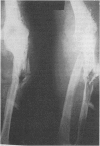Abstract
The nature of modern conflicts precludes adequate medical care for most people wounded in wars. The traditional military approach of echeloned care for those wounded on the battlefield has limited relevance. I present an alternative, epidemiological approach whereby some effective care may reach many more. For a surgical facility to have a positive impact by using surgical and anaesthetic competence there must be access to the wounded; security for staff and patients; and a functioning hospital infrastructure. These all depend on respect for the first Geneva convention. Early hospital admission for urgent surgery is not so important if there is adequate first aid beforehand. The hospitals of the International Committee of the Red Cross have provided surgical care for thousands of wounded people by fulfilling these conditions. People wounded in modern conflicts would fare better if these priorities were recognised and less emphasis was placed on the more spectacular aspects of surgical care that benefit only a few.
Full text
PDF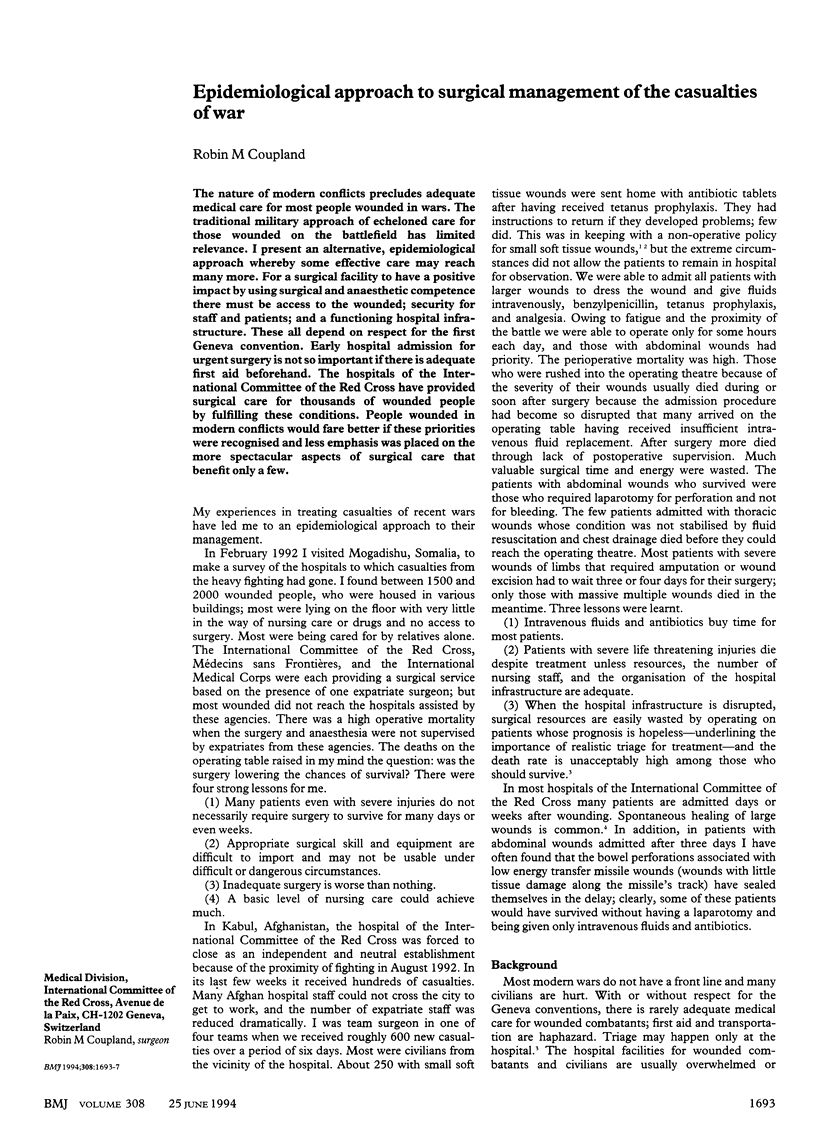
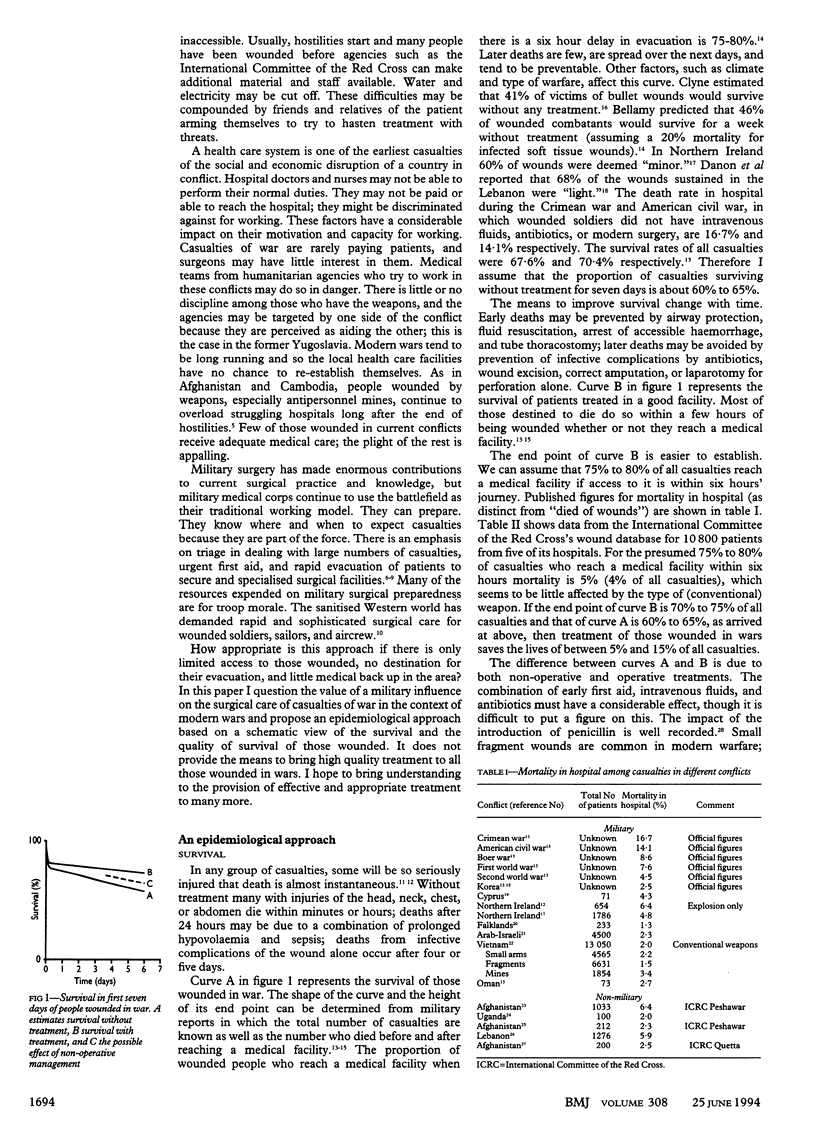
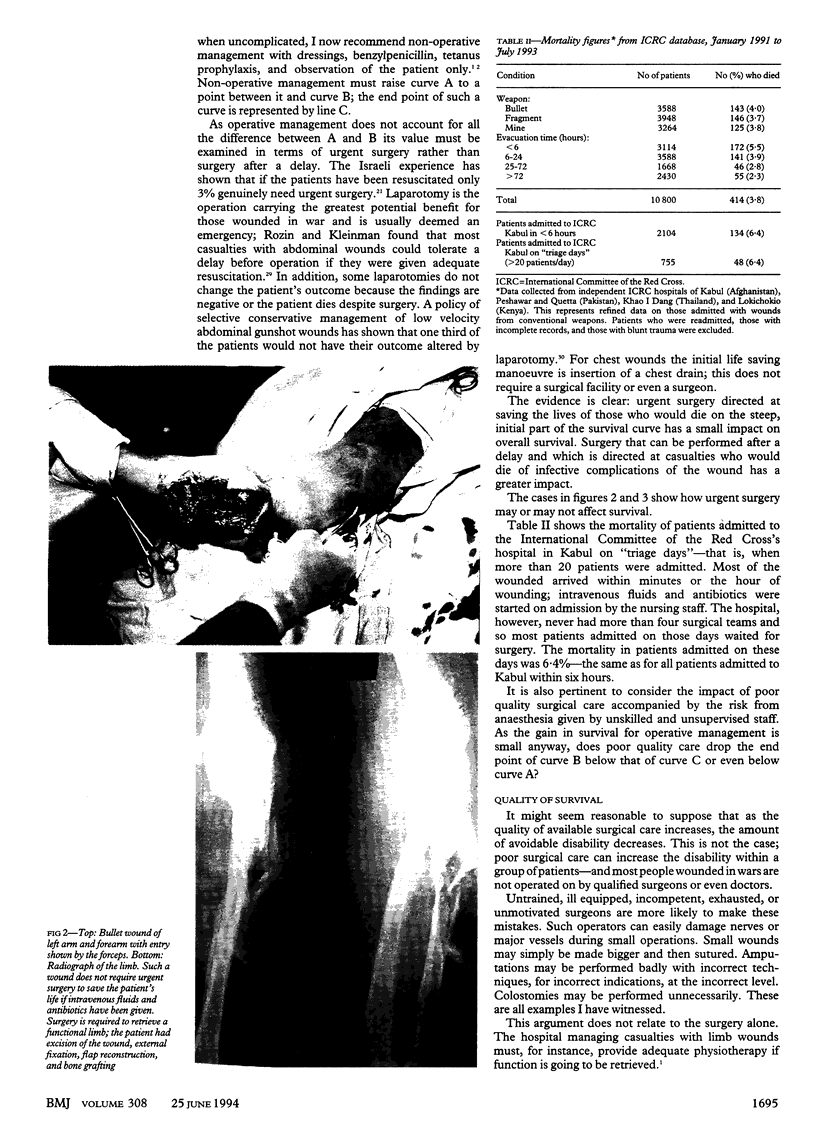
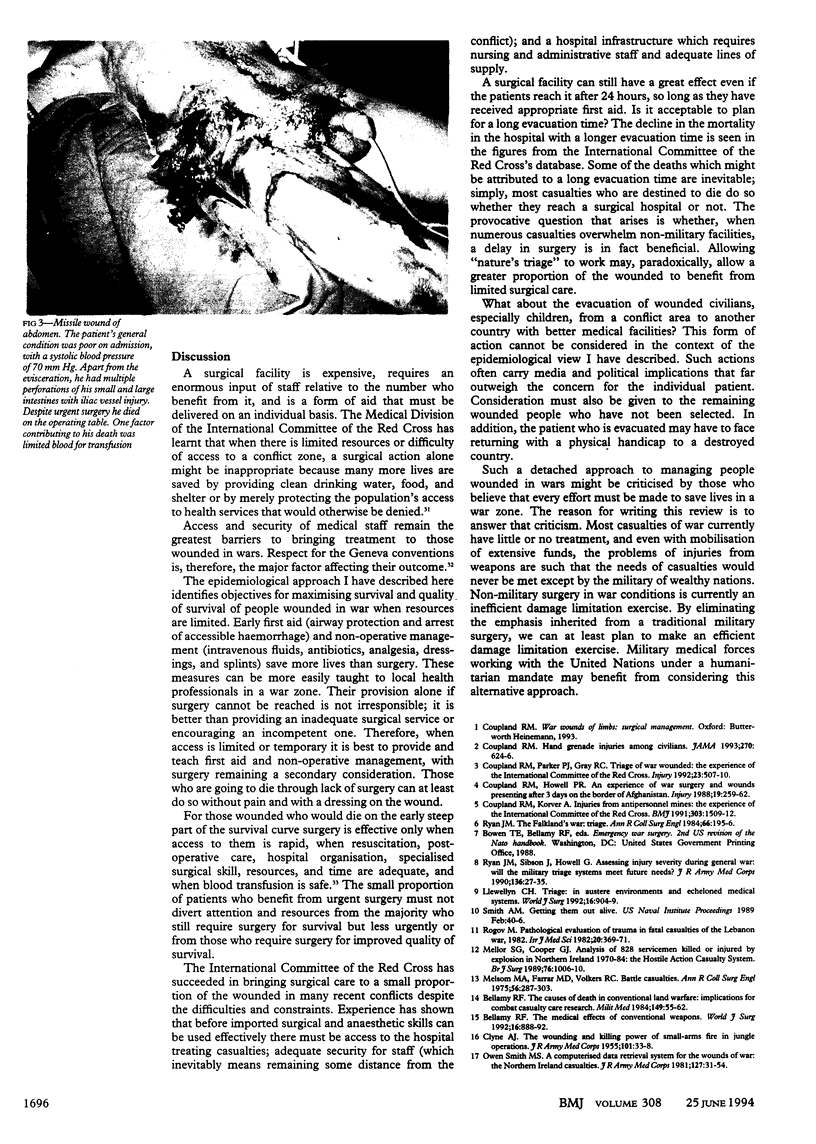

Images in this article
Selected References
These references are in PubMed. This may not be the complete list of references from this article.
- Bellamy R. F. The causes of death in conventional land warfare: implications for combat casualty care research. Mil Med. 1984 Feb;149(2):55–62. [PubMed] [Google Scholar]
- Bellamy R. F. The medical effects of conventional weapons. World J Surg. 1992 Sep-Oct;16(5):888–892. doi: 10.1007/BF02066987. [DOI] [PubMed] [Google Scholar]
- CLYNE A. J. The wounding and killing power of small-arms fire in jungle operations. J R Army Med Corps. 1955 Jan;101(1):33–38. [PubMed] [Google Scholar]
- Coupland R. M., Howell P. R. An experience of war surgery and wounds presenting after 3 days on the border of Afghanistan. Injury. 1988 Jul;19(4):259–262. doi: 10.1016/0020-1383(88)90041-1. [DOI] [PubMed] [Google Scholar]
- Coupland R. M., Korver A. Injuries from antipersonnel mines: the experience of the International Committee of the Red Cross. BMJ. 1991 Dec 14;303(6816):1509–1512. doi: 10.1136/bmj.303.6816.1509. [DOI] [PMC free article] [PubMed] [Google Scholar]
- Coupland R. M., Parker P. J., Gray R. C. Triage of war wounded: the experience of the International Committee of the Red Cross. Injury. 1992;23(8):507–510. doi: 10.1016/0020-1383(92)90146-j. [DOI] [PubMed] [Google Scholar]
- Cutting P. A., Agha R. Surgery in a Palestinian refugee camp. Injury. 1992;23(6):405–409. doi: 10.1016/0020-1383(92)90018-n. [DOI] [PubMed] [Google Scholar]
- Danon Y. L., Nili E., Dolev E. Primary treatment of battle casualties in the Lebanon War, 1982. Isr J Med Sci. 1984 Apr;20(4):300–302. [PubMed] [Google Scholar]
- Eshaya-Chauvin B., Coupland R. M. Transfusion requirements for the management of war injured: the experience of the International Committee of the Red Cross. Br J Anaesth. 1992 Feb;68(2):221–223. doi: 10.1093/bja/68.2.221. [DOI] [PubMed] [Google Scholar]
- Fraser I. Penicillin: early trials in war casualties. Br Med J (Clin Res Ed) 1984 Dec 22;289(6460):1723–1725. doi: 10.1136/bmj.289.6460.1723. [DOI] [PMC free article] [PubMed] [Google Scholar]
- Gertsch P. Assessment of hospital workload in war surgery. Br J Surg. 1987 Sep;74(9):831–833. doi: 10.1002/bjs.1800740928. [DOI] [PubMed] [Google Scholar]
- Hardaway R. M., 3rd Viet Nam wound analysis. J Trauma. 1978 Sep;18(9):635–643. doi: 10.1097/00005373-197809000-00004. [DOI] [PubMed] [Google Scholar]
- Jackson D. S., Batty C. G., Ryan J. M., McGregor W. S. The Falklands war: Army field surgical experience. Ann R Coll Surg Engl. 1983 Sep;65(5):281–285. [PMC free article] [PubMed] [Google Scholar]
- Malpass C. P., Winter J. S. A report on missile injuries in Cyprus 1974. Br J Surg. 1976 Jun;63(6):482–487. doi: 10.1002/bjs.1800630621. [DOI] [PubMed] [Google Scholar]
- Mellor S. G., Cooper G. J. Analysis of 828 servicemen killed or injured by explosion in Northern Ireland 1970-84: the Hostile Action Casualty System. Br J Surg. 1989 Oct;76(10):1006–1010. doi: 10.1002/bjs.1800761006. [DOI] [PubMed] [Google Scholar]
- Melsom M. A., Farrar M. D., Volkers R. C. Battle casualities. Ann R Coll Surg Engl. 1975 Jun;56(6):289–303. [PMC free article] [PubMed] [Google Scholar]
- Muckart D. J., Abdool-Carrim A. T., King B. Selective conservative management of abdominal gunshot wounds: a prospective study. Br J Surg. 1990 Jun;77(6):652–655. doi: 10.1002/bjs.1800770620. [DOI] [PubMed] [Google Scholar]
- Owen-Smith M. S. Hunterian lecture 1980: a computerized data retrieval system for the wounds for war: the Northern Ireland casualties. J R Army Med Corps. 1981 Feb;127(1):31–54. doi: 10.1136/jramc-127-01-16. [DOI] [PubMed] [Google Scholar]
- Rautio J., Paavolainen P. Afghan war wounded: experience with 200 cases. J Trauma. 1988 Apr;28(4):523–525. doi: 10.1097/00005373-198804000-00019. [DOI] [PubMed] [Google Scholar]
- Rozin R. R., Kleinman Y. Surgical priorities of abdominal wounded in a combat situation. J Trauma. 1987 Jun;27(6):656–660. [PubMed] [Google Scholar]
- Rozin R., Klausner J. M., Dolev E. New concepts of forward combat surgery. Injury. 1988 May;19(3):193–197. doi: 10.1016/0020-1383(88)90014-9. [DOI] [PubMed] [Google Scholar]
- Ryan J. M., Sibson J., Howell G. Assessing injury severity during general war. Will the Military Triage system meet future needs? J R Army Med Corps. 1990 Feb;136(1):27–35. doi: 10.1136/jramc-136-01-04. [DOI] [PubMed] [Google Scholar]
- Ryan J. M. The Falklands war--triage. Ann R Coll Surg Engl. 1984 May;66(3):195–196. [PMC free article] [PubMed] [Google Scholar]
- Trouwborst A., Weber B. K., Dufour D. Medical statistics of battlefield casualties. Injury. 1987 Mar;18(2):96–99. doi: 10.1016/0020-1383(87)90181-1. [DOI] [PubMed] [Google Scholar]
- de Wind C. M. War injuries treated under primitive circumstances: experiences in an Ugandan mission hospital. Ann R Coll Surg Engl. 1987 Sep;69(5):193–195. [PMC free article] [PubMed] [Google Scholar]




